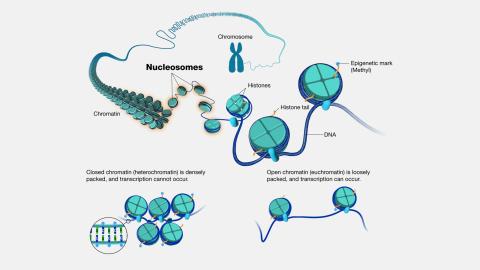What happens when you squeeze DNA? Can pressure reveal something about how our genetic material is packed, protected, and accessed?
Dr. Kushol Gupta, a structural biologist at the University of Pennsylvania, is pursuing this question and found that turning up the pressure might be one of the best ways to peek into how life organizes itself at the atomic scale.
In a new study published in Chromosome Research, Gupta and collaborators used high-pressure small-angle X-ray scattering (HP-SAXS) at CHESS to explore how different parts of our DNA, particularly nucleosomes, respond to extreme physical stress.
Experiments were carried out at the NSF and NIH-funded beamline ID7A1 at CHESS using a custom-built hydrostatic pressure cell that was designed by Durgesh Rai and Richard Gillilan and is capable of reaching upwards of 400 megapascals (MPa), i.e., roughly 4,000 times atmospheric pressure, or four times the pressure at the bottom of the Mariana Trench.
Cracking Open the Chromatin Code
Inside each cell, DNA is tightly packed into a material called chromatin, which is made up of DNA and proteins that help organize the genome and control gene activity.
Nucleosomes are the molecular “reels” that organize our DNA, helping package nearly six feet of genetic material into each tiny cell. The canonical nucleosome consists of DNA coiled around a core of histone H3 proteins. But not all nucleosomes are created equal. Some nucleosomes are found at the centromere, the region of a chromosome that plays a key role in cell division, and contain a specialized protein called CENP-A, a variant of histone H3.
“Centromeric nucleosomes are unique in both their composition and their function,” said Gupta. “But understanding what makes them physically different from conventional nucleosomes has been difficult, especially in realistic, solution-based environments.”
Gupta, a crystallographer by training, specializes in using scattering techniques to study biological structures, and wanted to go beyond static snapshots of these particles. He wanted to see how they behave, flex, and respond under pressure.
What they found was quite revealing.

Why Pressure?
Enter the BioSAXS beamline at CHESS and its newly developed HP-SAXS capabilities. CHESS beamline ID7A1 is one of the only places in the U.S. where researchers can perform high-pressure X-ray scattering experiments on biological samples.
Gupta’s team applied increasing amounts of pressure, up to 300 megapascals, or roughly 3,000 times atmospheric pressure, to nucleosome samples in solution. This mimics the kind of stress experienced by deep-sea organisms as well as human DNA, where genetic material is tightly packed into chromatin structures.
The results showed a notable contrast between the two types of nucleosomes.
“As we increased the pressure, we saw that conventional nucleosomes began to partially unfold. Essentially, the DNA unwrapped from the histone core,” said Gupta. “But the centromeric nucleosomes, which contain CENP-A, held together much better. They were structurally more resilient.”
Gupta was surprised when both types of nucleosomes returned to their original shape as the pressure was released, “We weren’t expecting that. The deformation was largely reversible’,” he said.
Pushing Biology to Its Limits
Gupta said that CHESS’ BioSAXS beamline functions as a kind of “molecular stress test lab”, a place where researchers can apply carefully controlled conditions like pressure, temperature, or anaerobic conditions to probe the behavior of biological systems.
“What’s powerful about pressure is that it doesn’t require altering the molecules you’re studying,” he explained. “You’re not mutating the DNA or adding chemicals. You’re simply perturbing the system and watching how it responds.”
This approach, he noted, offers a more natural way to explore structure and stability, particularly in systems like chromatin that are difficult to study under static or artificial conditions.
Opening New Frontiers
Gupta is already applying the same HP-SAXS techniques at CHESS to study vaccine-related particles, protein-protein interactions, and enzyme-ligand binding states.
For chromatin research specifically, the ability to use pressure as a structural probe could help scientists understand:
- How chromosomes maintain their integrity during cell division
- How gene expression is regulated through subtle physical changes
- How life survives in extreme environments like the deep ocean
This work highlights the potential of high-pressure SAXS as a powerful, non-invasive tool for studying chromatin structure and dynamics in solution. Gupta emphasized that the combination of high pressure and small-angle scattering is still relatively new to the field, but growing quickly.
“There’s a lot we still don’t understand about how chromatin behaves under stress or in extreme environments,” he said. “This capability at CHESS gives us a way to ask those questions directly, with the kinds of experimental control and flexibility that are hard to find elsewhere.”
This work is based in part on research conducted at the Center for High-Energy X-ray Sciences (CHEXS), which is supported by the National Science Foundation (BIO, ENG and MPS Directorates) under award DMR-2342336, and the Macromolecular Diffraction at CHESS (MacCHESS) facility, which is supported by award 1-P30-GM124166 from the National Institute of General Medical Sciences, and the National Institutes of Health.
